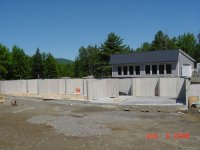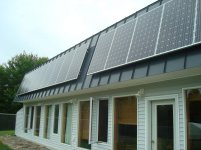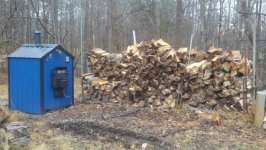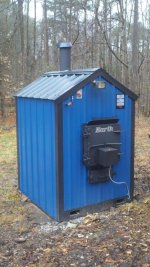Aaron Z,
I apologize for the comment made last night. Some of the posts were deleted but I did get an email from you asking to explain why your math is incorrect so please let me explain.
In your message you ended by saying that if I wanted to compare cubic feet of pollutants per BTU of output (or BTU of effective output to account for the inefficiencies of having your boiler outside) that would be a fair comparison.
OK let's build on your last statement.
I think we both can agree that an EPA certified indoor wood boiler will emit approximately 7 grams of PM 2.5 per hour. Phase II OWBs if sized correctly and using dry hardwood emit approximately 20 GPH maybe more maybe less but for the sake of this explanation let's just use these numbers. You are right during the time span of one hour the OWB is heating 2000 Square Feet and the Indoor Wood Burner 300 Square Feet. I'm sure we can also agree that the reason the OWB is putting out more GPH of PM 2.5 is for the simple fact that it is consuming more wood to heat the entire house. No argument here.
Now before we move forward let me explain how air quality is measured. If we use EPA's National Ambient Air Quality Standard for PM 2.5 it states that during a 24 hour period air quality cannot exceed 35 micrograms per meter cubed. Just a side note here, NAAQS function is to measure air quality effected by cross state pollution and/or large industrial complexes near population centers. It uses three year averages of the 98 percentile reading etc., to arrive at its conclusions. Then it gives the suspect industry or state five years or so to fix the problem. So as you can see this is not the appropriate tool for measuring air quality from one OWB effecting a neighbor. That being said, there are portable monitors that can be used or computer modeling to ascertain the results. Modeling can be tricky because based on the input variables outputs can vary. I won't go into that now. However, the math used in modeling is fairly straight forward absent chimney heights, air inversions, setbacks, terrain, adjacent buildings, trees etc.
To show the math let's use a simple scenario. Again, this is a simple scenario to show how the math works nothing more - bare with me.
On one end we have an OWB with an eight foot chimney. 100 meters away (300 feet) on a flat piece of terrain with no trees or other obstacles we have a 50 foot wide ranch style house. There is a clear line of sight between the OWB and the house. Today's weather presents a temperature inversion with a 2.2 MPH wind. One MPH is considered calm in weather circles. For those of you that don't know temp inversions are a frequent weather condition that traps air close to the surface.
Now when we examine the EPA criteria for safe air it states there can no more than 35 micrograms per meter squared per 24 hour average. What is a meter squared? Basically, picture an imaginary box floating in the air with each side 1 meter long. If the pollutant PM 2.5 passes through that box or occupies the box at a level greater than an average of 35 micrograms per 24 hour period then the EPA considers the air unsafe.
So the OWB is operating and as the smoke exits the chimney it turns horizontal because of the temp inversion and a 2.2 MPH wind. The plume is 10 meters wide and 20 meters high. So essentially we have 20,000 cubic meter box (10 meters wide x 20 meters high x 100 meters long) the smoke is traveling in. The ranch home is downwind so the smoke travels toward it. Again, the temp inversion is holding the smoke close to the ground and it looks like a smoke fog. Now the math:
- There are 1,000,000 micrograms in a gram. (Microgram shorthand is ug)
- If the OWB is emitting 20 GPH that is 333333 ug / minute (20,000,000 divided by 60 )
- If the air moves past the stack at 2.2 MPH (1m/second) it takes 100 sec to go 100 meters. That equates to about 1.666 minutes.
- The amount of PM 2.5 released during 1.666 minutes is 1.6666 x 333333 = 555332.77 ug
- Since our measurement box is 20,000 cubic meters (10X20x1000) we get 555332.27 divided by 20000 = 27.8 ug meter cubed (within air quality standards assuming a constant 20 GPH over 24 hour period)
Now use a 1MPH wind speed instead and see the difference wind or lack of will make.
The conversion from MPH to meters/second is: MPH * 0.44704 so a 1 MPH wind now takes 3.72822 minutes to travel to the home. ( Think about it this way the longer the time period the more PM that is added to the air box being measured -meaning more saturation before moving past the home..
Also note there is a normal 10ug PM 2.5 background amount that is almost always present so this needs to be added to your results. PM 2.5 is accumulative. What would the 10 ug background level do the result above? Don't forget to add it to the result of your 1 MPH equation.
You can find your current PM 2.5 at this site:
http://airnow.gov/index.cfm?action=aqibasics.aqi
Type in your zip and you'll see your AQI number on the right. Under "quick Links" click on AQI to concentration. In the drop down box click on pollutant. (PM 2.5) Now enter your AQI number from the previous page and hit calculate. This is your current background number. As stated 10 is a safe average number to use.
Now do the same equations for an indoor wood burner emitting 7 GPH with a 1 MPH wind.
Next use 70 GPH with a 1 MPH wind. This will give you an idea what neighbors are facing when in proximity to an early model OWB. This is why my frequent mentioning of lawsuits that are becoming more common. Some product liability attorneys are now using these modeling programs along with NESCAUM and the EPA's findings. Many people don't know this.
Hopefully this explains the difference between an indoor wood burner and an OWB with respect to air quality. Let me know if I can answer any questions. This will get you in the ballpark mathematically.
skybox



